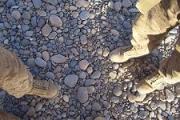For those soldiers, sailors and airmen who participated in D-Day, June 6 was unlike any day in history. And it was on D-Day that Dick Winters had his rendezvous with destiny. Easy Company's mission, as with the other units within the 101st Airborne Division, was to seize the causeways behind Utah Beach to facilitate the expansion of the beachhead. Jumping from a C-47 Dakota at 150 miles per hour and at 500 feet and less, the Division's drop was scattered across the Cotentin Peninsula. Winters came down near the town of Ste. Mere-Eglise, several kilometers from the intended drop zone. Rallying a couple of troopers, he soon was en route to Ste. Marie-du-Mont, destined to be the Division's headquarters for most of D-Day. En route, Winters stumbled across the battalion staff and 40 men of D Company. By 7:00 a.m., E Company consisted of two light machine guns, one bazooka with no ammunition, one 60 mm mortar, nine riflemen and two officers. No one knew the whereabouts of the company commander, so Winters took command.
Three kilometers from Ste. Marie-du-Mont, the column encountered sustained enemy fire, and Winters was summoned to the front. The battalion commander informed Winters that there was a four-gun battery of German 105 mm cannons, a few hundred meters to the front across an open field opposite a French farmhouse called Brécourt Manor. The battery was set up in a hedgerow and defended by a 50-man German platoon. The guns were firing directly down a causeway leading to Utah Beach. The battalion operations officer directed Winters to take the battery. Taking his company, Winters made a careful reconnaissance and then issued orders for an assault.
The attack would consist of a frontal assault led by Winters with covering fire from several directions to pin down the Germans. Winters selected three soldiers for the assault: Pvt. Gerald Lorraine, Pvt. Popeye Wynn and Cpl. Joe Toye. Asked later why he selected these three, Winters recalled, "In combat you look for killers.' Many thought they were killers and wanted to prove it. They are, however, few and far between."
Winters saw the impending attack as a "high risk opportunity." The key was "initiative, an immediate appraisal of situation, the use of terrain to get into the connecting trench and taking one gun at a time." Crawling on their bellies, Winters and his men got close enough and knocked out the first gun. Mowing down the retreating Germans, Winters then placed a machine gun to fire down the trench. He had also noticed that as soon as he got close enough to assault the first gun, the Germans in an adjacent hedgerow temporary lifted their fire so that they would not inflict friendly casualties. That was enough for Winters, who had a "sixth sense" that such a respite shifted the advantage to him.
With the first gun out of action, Winters grabbed two other soldiers and charged the second gun. Throwing hand grenades and firing their rifles, they took the second howitzer. Next to the gun was a case with a map that showed all the German artillery in the Cotentin Peninsula. Winters sent the map back to battalion headquarters and then directed another assault which rapidly captured the third gun. Reinforcements led by an officer from D Company soon arrived. Winters briefly outlined the situation and then watched D Company capture the last gun. With the mission complete, Winters ordered a withdrawal. It was 11:30 a.m., roughly three hours since Winters had received the order to take the battery.
In summarizing Easy's action, historian Stephen Ambrose notes that with 12 men, what amounted to a squad, later reinforced by elements of D Company, Winters had destroyed a German battery, killed 15 Germans, wounded many more, and taken 12 prisoners. It would be a gross exaggeration to say that Easy Company saved the day at Utah Beach, but reasonable to say that it had made an important contribution to the success of the invasion.
Winters' action at Brécourt Manor was a textbook infantry assault, frequently studied at the U.S. Military Academy. Ever the self-effacing leader, Winters described the action to combat historian S.L.A. Marshall simply as laying down a base of fire to cover the assault. Left unsaid was his leadership by example. At every turn he had made the correct decision, from selecting the right men for each task, to making an accurate reconnaissance of the enemy position, to leading the maneuver element in person. In his own analysis, Winters credited his training and preparing for D-Day, his "apogee" in command. When the day was finally over, he wrote in his diary that if he survived the war, he would find an isolated farm somewhere and spend the rest of his life in peace.













 :
:


 "A Sherman can give you a very nice... edge."- Oddball,
"A Sherman can give you a very nice... edge."- Oddball, 
Bookmarks